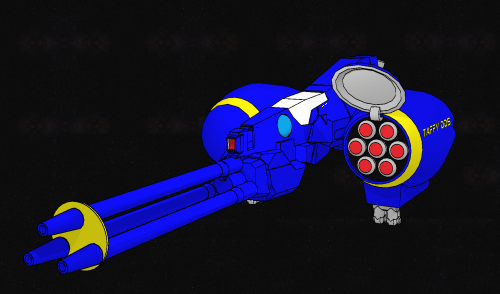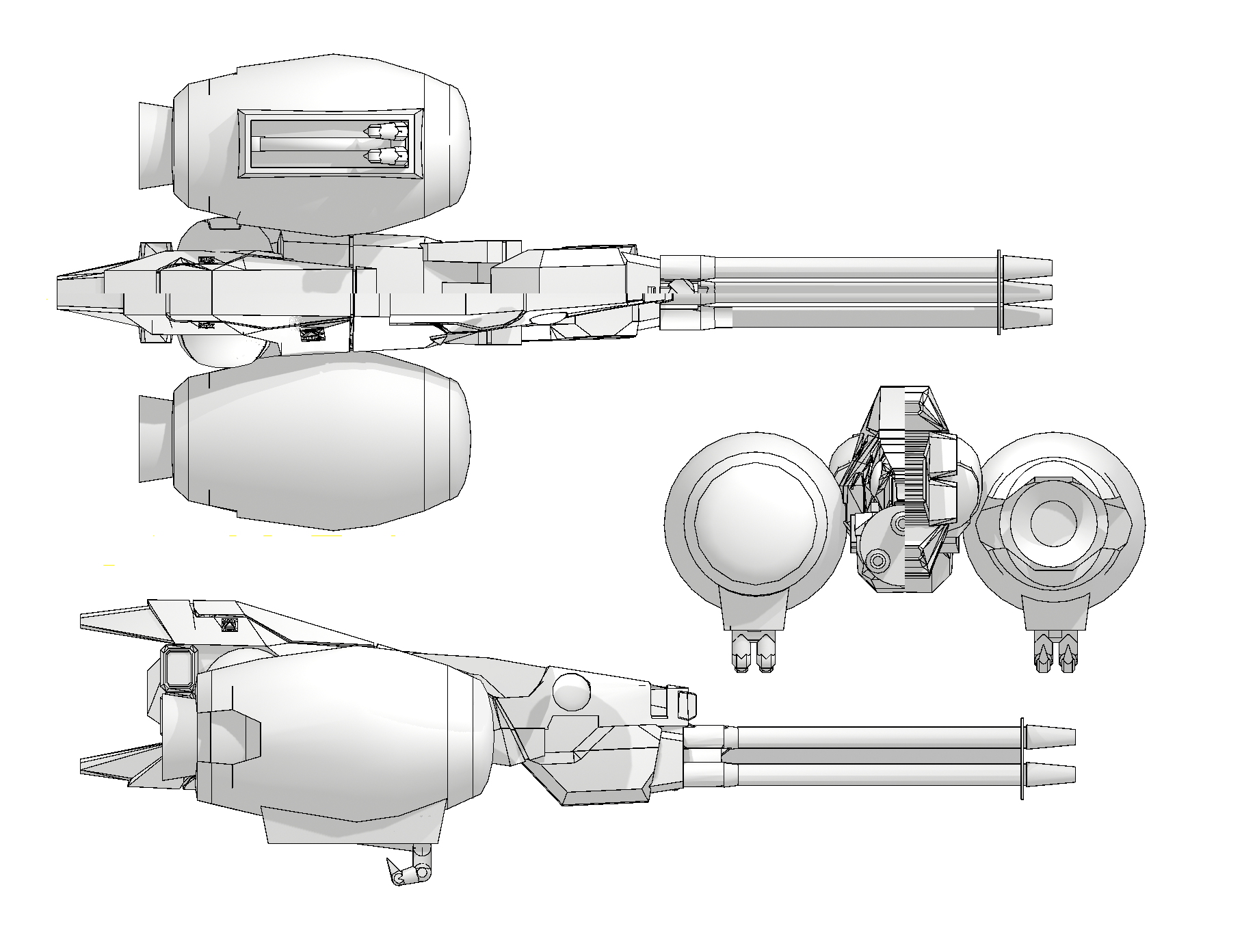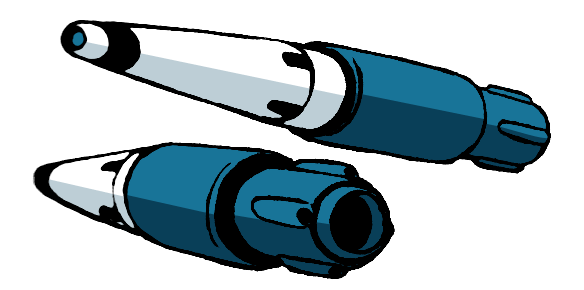 | Spacer II Space Fighter. |  |
|---|
| Terran United Nations. | Terran United Nations. |
|---|
When they first came out the Lancer II Space Fighter was in fact manned; Developed before the arrival of The Visitor, the Lancer would have been a game changer but for the advent of ROBOTECHNOLOGY. Despite being exactly what the Internationalist faction wanted and needed of a space fighter, field testing revealed the fighter wasn't up to the challenge the early Veritechs presented, and they were converted to unmanned. The new Spacer Space fighter is the UGC's second-line space fighter. The Lancer II Space fighter saw extensive service during the Malcontent Uprising Era on Earth in the hands of the RDF, EBSIS and EBSIS  |  | | A Typical Spacer II Space Fighter. "TAFFY DD-5" Indicates It's Off Of UGC TAFFY, The Fantoman Based ARMOR-Class That Serves As The Chairman's Personal Honor Guard. | A Typical Spacer II Space Fighter. "TAFFY DD-5" Indicates It's Off Of UGC TAFFY, The Fantoman Based ARMOR-Class That Serves As The Chairman's Personal Honor Guard. |
|---|
supported terrorists, and various malcontent groups. As the era drew to a close, the last of the craft were either captured or destroyed. With over 3,000 frames, the RDF did not have time to deal with destroying them all and packed the majority away about a tender that had been detailed to the Pioneer Mission for later disposal, though many suggestions that the craft could be offered to potential strategic allies were offered in the process. Upon arrival at Fantoma/Tirol and discovering the major astro political upheavals that had occurred, the Lancers that were on available to offered to those 'potential strategic allies' with additional offers to help rebuild them to more modern standards. Most of the Sentinel Alliance members accepted them for home world defense use once their day of liberation came. The Carbanarans in particular turned to in rebuilding the frames. First they swapped out the Terran designed powerplant for something far more efficient (and hydrogen rather than Sekiton based). Next they replaced the auto cannons with RDF Raider X RRG mk15 laser cannons and added missile launcher based on the RDF Spartan's SHM-10 arms. These then went into service as Sentinel worlds were liberated, though the REF refused to press them into service before that as they would not be adequate to deal with Invid mecha.
As the Sentinel Campaign wound down, the REF and allied worlds understood the continued need for defensive capabilities, and licensed Spacer fighters to hose member states on the condition they be used for defensive purposes only. With this came with some design changes to the frame, which was lengthened about 3 feet to accommodate the wider variety of species that would be the pilots, and the normally square aft thruster ports were replaced by one large oval thruster port.
All of these features remain in the UGC variant; However, unlike the EBSIS native design, the UGC kept the short range missile launchers and additionally installed a full-barrier force field for added protection from surprise attack. The missile thrust ducting nozzles have been linked to the main drive thrust, increasing maneuverability, and an automated missile thrust compensation system either ducts missile thrust gasses to both ducts evenly or diverts thrust from the main drives to prevent the craft from twisting off course when fired.
The disadvantage of the design, obviously, was one of its strengths- Its biological pilot. One carefully placed or lucky shot, and that's all she wrote for one more person. This is overcome by issuing pilots VR-051 Battler Cyclones.
The Spacer II was a very common sight throughout the UGC, and units captured by various malcontents are routinely repainted and put back into service. Fehran Malcontents extensively overhaul them into aero-space fighters. This rebuild has not found favor outside the Fehrans, and in fact has found extensive disdain by the UGC for the waste of resources the design, designated Fehran Malcontent Fighter, represents.
However, the Hornet Guardian has overtaken the venerable Spacer, and they've been relegated to second line duties; Plans are being made to take the fleet completely off-line for the Robotech Expeditionary Forces, or to convert them to the automated configuration of the First Robotech War. With the arrival of the ASF-21 Sholagar Fighter the Spacer II is slated to be fully decommissioned by the RDF's as well by not later than 2700, with the frames being converted to navigational beacons and automated perimeter defense until something better comes along.
Name: Spacer II Space Fighter
Model Type: Space Fighter
Class: Military and Civil Defense
Crew: 1
Passengers: None.
MDC By Location: |
Fuselage-
Cockpit-
Radar Pod-
Missile Pods (2)- | 200
150
75
150 each | Landing Struts (3)-
Thruster-
Cannons (4)-
Full-Force Barrier Field- | 25 each
75 each
100 each
20 |
| Speed and Statistical Data: |
In space: 1,450 mph
Range:.1 light year. Can be refueled underway.
On the Ground:.1 MPH
Range on the Ground: 1 mile max.
Length: 50 feet.
Width: 8 feet.
Height: 10 feet. | Weight: 15 tones.
Cargo: Pilot supplies only.
Power System: TJR-601 Hydrogen Thrusters; Output: 221 KWh at 22,000 hsp; Lifespan: 20,000 flight-hours.
Flight System: Grav pods only. The Spacer II has no other flight system possible.
Thrust System: Bleed off from power plant.
Cost and Availability: 25,000 to 30,000credit Regularly available. |
| Weapons Systems: |
|---|
1. Laser Cannons (2): The Spacer I switched out the original auto cannons of the Lancer I for the laser cannons used on the RDF Raidar X. The UGC variant utilizes the REF version.
Purpose: Offense
MD: 1D10 short burst, 2D10 heavy burst, 3D10 maximum burst per laser.
Rate of Fire: 8 short, 4 heavy, or 4 maximum bursts per melee, per laser.
Range: 8 miles
Payload: Unlimited.
Cost: 100,000credit each.
Availability: Commonly available
2. 60 Long and Medium Range Missiles: Using a missile pods directly based on the Spartan missile pod arms.
Purpose: Assault
Missile Type: Medium and Long Range.
MD and Range: Varies by type used.
Rate of Fire: Volleys of 1, 2, 5, 10, 15, or 30 times pilot's attacks. NOTE: Only 15 missiles per launcher are available at a time, however, used missiles are immediately replaced.
Payload: 30 per launcher (60 total)
Cost: 10,000credit each.
Availability: Commonly available.
| 3. 40 SRM's: A popular choice with allied forces, this system is typically used as anti-missile batteries. Located on the underside of the fighter.
Purpose: Anti-Missile Defense
Missile Type: Short Range.
MD and Range: Varies by type used
Rate of Fire: Volleys of 2, 4, 5, or 10 times pilots attacks per melee.
Payload: 40
Cost: 3,000credit each.
Availability: Routinely available

4. Sheilds: In the last block, the Spacer received a substantial shielding upgrade; Full-force variable shield WITH a secondary read-facing Pinpoint Shield to protect against pursuers.
MDC: Variable: 100 per panel (600 total); Fixed Aft: 150. |
| Features: |
- Radar: Combat grade radar. Range: 200 miles, can track up to 250 individual targets. 95% reliability (24% against unfriendly stealthed vehicles).
- ESM: Radar Detector. Passively detects other radars being operated.
- Full Range Sensory Suite: Infrared, ultra violet, Magnification, night sight, color filters, thermal imager. Range is about 2,000 miles for MOST sensors.
- Sensory Systems: The craft is equipped with sensors very similar to those carried by the SR-71 and other spycraft; However, some of the higher end material is NOT carried, as the possibility of being shot down is too great. Note that the sensors on this craft is nowhere near as extensive as it's larger brothers.
Optic Systems:
Infrared: 20 miles, Magnification: 15 times
Ultra Violet: 22 miles, Magnification: 25 times
Night Vision: 24 miles, Magnification: 8 times
Color Filters: 19 miles, Magnification: 200 times
Thermal Imager: 10 miles, Magnification: 40 times - Motion Detector: Activates a loud wailing when an object is coming at the user fast, and a soft ringing if it's coming slowly. Activation ranges must be specified by the pilot.
- FLIR/SLIR: Forward and Side Looking Infrared. Allows pilot and weapons officer to get visuals on targets at night.
- Video Recorder: Records from sensors and the cockpit itself. 500 hours of recording available.
- HUD: Displays maps, radar, targeting information, and any OTHER information the wearer wants directly in front of the user.
- AJP: Active Jamming Pod. Causes-25% to detection but when it is active, other vehicles/bases can detect that it is jamming, and some missiles will home in on jamming signals. Jamming also causes a-4 penalty to all radar guided weapons.
- Anti-Jamming System: Reduces Electronics Countermeasure by 3/4 (decrease skill level appropriately).
- Electronic Counter Measures (ECM): These systems disrupt enemy radar and tracking systems, making it difficult for them to lock onto the ship with weapons. The countermeasures give the Mecha a +3 to dodge, +2 to strike and +1 on initiative in combat.
- AMC/FD (2): Anti-Missile Chaff/Flare Dispensers. Actually launches a glob of burning magnesium/aluminum alloy to confuse both radar AND heat sensory systems. Fires off 04 chaff/flares each time it is activated. The system is KNOWN to work on all KNOWN radar and infrared systems, but concerns continue that somewhere out there their MIGHT be a system that will be totally unaffected by the system. Reduce effects by 20% against smart missiles (add +20% to rolls for smart missiles.)
Effect:
01-50: Enemy missile or missile volley detonates in chaff cloud- Missiles are all destroyed
51-75: Enemy missile or missile volley loses track of real target and veers away in wrong direction (may lock onto another target).
76-00: No effect, missile is still on target.
Also note that the chaff cloud will also blind nearby heat sensors (and optically based sensors at night) for 1 melee. They will suffer the following penalties: Reduce melee attacks/actions, and combat bonuses by half.
Duration: 1D4 melee rounds.
Payload: 60 chaff/flares. Each time the system is engaged, the system fires off 04 chaff/flares. - MRA 6 Radios: Allows real time, continuous radio link up with friendly forces in the area via satellite relay over laser radio signals, preventing jamming, and automatically encrypts/decrypts same to prevent eavesdropping.
- Type-11 wide band radios: Effective 10 mile range, auto encrypt/decrypt. Works on standard radio band wavelengths, so it can still be jammed (if the enemy knows the frequencies).
| - GPS: Standard tracking device.
- LDP (4): Launched Decoy Pods. Located on the top of the port and starboard wingtips. The fighter can carry a special pod that carries four advanced decoy drones. These drones are launched to go where ever they want for 30 minutes. Each is a specially designed radar lure that creates a radar image to mimic the fighter. If decoys are not destroyed, they can be recovered and repaired. This system has been successfully deployed against SEVERAL alien radar-type sensors (including one that works off of sound).
MDC: 5
Effects: The decoy has a 98% chance of fooling ordinary non military radars and non smart guided missiles, and a 90% chance of fooling military grade radars and advanced smart missiles.
Range: Towed to 328 feet (100 meters) from the fighter or released to go wherever it wants. Can fly independently for about 30 minutes.
Rate of fire: One can be tether deployed at a time and requires 15 seconds to deploy another decoy. Any non-loosed decoys can be reeled in again.
Payload: 16 Decoys total. - Smoke Dispensers (8): Throws out smoke flares capable of covering a 250 square foot area. Special chemicals in the smoke obscures IR and heat sensors, and defeats visual tracking of the vehicle. Note that it DOESN'T make the vehicle invisible, but simply negates ALL bonuses to strike.
- Combat/Targeting Computer: Records all enemy and friendly activity over the course of time; Can replay that activity for the pilot, assign target designation numbers, and track likely damage based on mathematical formulas (i.e. "Right leg red" badly damaged/destroyed, "head green" not damaged, etc). Displays this information as a pop up in the HUD on request by the pilot.
- Blue Force Tracker: Identifies Friend from Foe. Overlays the information on both the radar and HUD, ensuring that friendly forces are not accidentally targeted.
- CBR Protection: Complete chemical, biohazard, and radiological protection.
- Vacuum Seal: Permits the fighter to be used in hard vacuum (such as outer space), and other hostile environments.
- Internal temperature and humidity control: Automatically maintains users desired heat, humidity, and other personal comfort settings.
- Heat And Radiation Shielding: Special shielding prevents the penetration of life threatening heat and radiation.
- Variable Tint Cockpit Canopy: Adjusts tinting to light conditions, up to an including a black dot if the sun is directly on the pilots face (only covers eyes).
- Survival Pack: A pack of simpler emergency survival supplies: Pup tent, sleeping bag, black light, GPS, First aid kit (bandages, gauze, bandage tape, pads, antiseptic/analgesic), plasma torch (for small repairs and starting fires), repair kit (with MDC Repair Spray), sewing kit (a small spool of thread and 5 needles), 7 star flares (250 foot apogee), 7 white parachute flares (1,500 foot apogee), 100 foot of black or brown parachute cord (150 lbs tensile strength), 2-5 days rations, 2 gallons water, water purification kit (good for about 10 gallons), manual-inflating liferaft (for at-sea abandonment), self-inflating lifevest (15# buoyancy). The liferaft can also double as a Pup Tent if so desired (though most pilots prefer to use a parachute for that, if anything, due to the fact that it is easier to hide).
- Oxygen Rebreather System: Extends pilots air supply to 100 hours; Cartridge MUST be replaced after that period of time.
- Virtual Map: Displays a continuously-updating map of local terrain for the pilot. Effective land navigation of 85% as updates come. Good to 50 miles. Specific range can be adjusted in 1 mile increments.
- XTNDR Pod: Originally deigned for use on ground vehicles and fixed stations, the XTNDR Pod has been adapted for use by spacecraft. The normal balloon is removed, and the pod simply drag behind the craft.
MDC By Location:
Pod: 50
Fiber Optic Cable: 10
Effect: Extends range of any sensors 10 times (or defeats other penalties in a 5 mile area).
|
Combat Bonuses from Spacer II Combat Elite:- 2 Additional attacks per melee.
- +3 Roll.
- +1 Strike.
- +6 Parry and dodge.
- One additional attack per melee at levels 6 and 11.
|




